Haworthia marumiana var. reddii
Haworthia marumiana Uitewaal var. reddii (C.L.Scott) M.B.Bayer
Family: Asphodelaceae
Common names: Waterdown Dam haworthia (Eng.), Klipplaat dwergaalwyntjie (Afr.)
Introduction
Haworthia marumiana var. reddii is a dwarf, mat-forming cliff-hugger, establishing clusters of numerous small rosettes of light green, succulent leaves on the cliffs along the Klipplaat River at Waterdown Dam, in the Eastern Cape. It flowers in spring and early summer, when the solitary inflorescence bearing white flowers, appears. Best grown in containers.

Fig. 1. A cluster of Haworthia marumiana var. reddii growing in its habitat on a sandstone cliff at the Waterdown Dam, Eastern Cape.
Description
Description
Plants dwarf-sized, neatly rosulate, prolific from base, developing into clusters that form small to large mats, up to 500 mm in diameter and consisting of more than 50 heads. Rosettes 30–50 mm in diameter. Roots grey, terete, up to 4 mm in diameter. Leaves about 18 to 25, soft, triangular-ovate, amplexicaul at base and partly imbricate, ascending, with incurved somewhat translucent apices; upper side flat to channelled or slightly convex; lower side cymbiform; surface smooth, green, becoming pinkish green during dry periods; margin entire or with soft teeth; apex acuminate, mucronate. Inflorescence racemose, 140–240 mm long, 10–20 flowered in distal half; bracts white, clasping, up to 3–4 mm long, ovate-acuminate; pedicels 2–4 mm long. Perianth tubular, curved, ascending-spreading, 17 mm long, white with purplish green midstripe. Capsule 5 × 2 mm. Seed 2.5 × 1.5 mm. Flowering is mainly from spring to early summer (October to November). Seeds are dispersed by wind, in summer and early autumn.

Fig. 2. A cluster of Haworthia marumiana var. reddii in flower, growing in the partial shade of sandstone rocks and grasses at the Waterdown Dam, sharing its habitat with Crassula orbicularis and Crassula capitella.
Conservation Status
Status
Haworthia marumiana var. reddii is Not Evaluated by the Red List of South African Plants and Haworthia marumiana is listed as Data Deficient – Taxonomically Problematic, needing to be revised using population-level molecular techniques to resolve species concepts. This variety is confined to the Klipplaat River at the Waterdown Dam, extending to near Queenstown, in the Eastern Cape. It is well protected by its difficult to reach, sheer cliff-face habitat and its distribution falls within a greater conservation region.
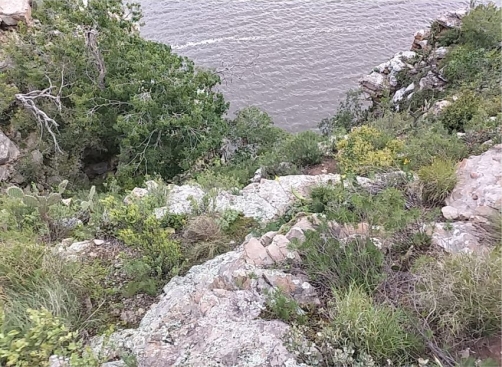
Fig. 3. A cliff face at the Waterdown Dam, habitat of Haworthia marumiana var. reddii.
Distribution and habitat
Distribution description
Haworthia marumiana var. reddii is known from the Klipplaat River extending its distribution to near Queenstown, in the Eastern Cape, growing on cliffs at an altitude of between 1 200 to 1 500 m. It grows mainly on shady, south-facing aspects, sometimes in the shade of local shrubs such as Diospyros scabrida, Buddleja saligna and Searsia erosa. Plants are rooted in crevices, forming small to large mats filling the space allowed by the crevice. Temperatures are high in summer (28–34°C). Winters are cold but frost is absent. Rainfall occurs throughout the year but with a peak in spring and summer, ranging from 250–400 mm per annum, in the form of thunder showers or cyclonic winter rain. The geology consists of quarzitic sandstone cliffs, Beaufort Group of the Karoo Supergroup. The cliff substrate has many ledges, crevices and fissures, ideal for establishment of plants.
The associated vegetation is Tarkastad Mountain Shrubland of the Grassland Biome (Mucina et al. 2006). Associated cliff-dwelling plants in its habitat include: Bulbine latifolia, Crassula nemorosa, C. orbicularis, C. perforata, C. nudicaulis and C. pellucida subsp. marginalis, Albuca bracteata and drooping mats of Delosperma subpetiolatum. Larger plants include: Crassula arborescens, Cussonia paniculata subsp. paniculata, Diospyros scabrida, Encephalartos friderici-guilielmi and Euryops floribundus. Grasses in its habitat are numerous and plants of Haworthia marumiana var. reddii are often covered by the grassy canopy.
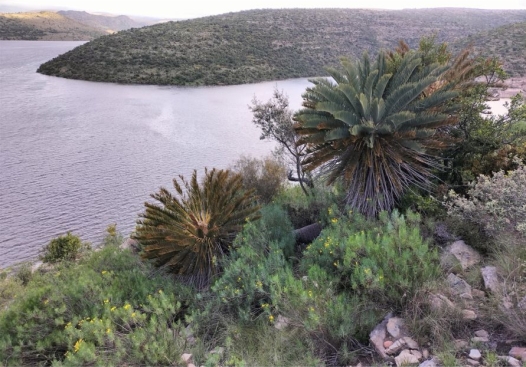
Fig. 4. Waterdown Dam, Eastern Cape. The cliffs above the dam are the habitat of Haworthia marumiana var. reddii. Note the Euryops floribundus (yellow) and the Encephalartos friderici-guilielmii in the foreground.
Derivation of name and historical aspects
History
Haworthia reddii was named by the South African Haworthia student, Charles Scott (1913–2001), for Dr V.B. Reddi from East London, who discovered the plants at Waterdown Dam in the Eastern Cape. Scott published his new species in 1994 in the Cactus and Succulent Journal of the Cactus and Succulent Society of America. Scott is well known for his book, The genus Haworthia, a taxonomic revision, published in 1985. Bruce Bayer, former curator of the Karoo National Botanical Garden and a Haworthia specialist at the time, related it as being part of the Haworthia cymbiformis complex and reduced the species to varietal status in 1999 (Haworthia cymbiformis var. reddii). Bruce subsequently changed his opinion and has now related it to the Haworthia marumiana complex, reflecting the variability and classification difficulties experienced with these dwarf plants in the genus Haworthia. Haworthia marumiana was named by the Dutchman Uitewaal in Cactussen en Vetplanten in 1940. The name honours Dr M. van Marum.
Haworthias remain one of the world’s most popular succulents, because of their attractive dwarf rosulate shape, and because plants are relatively easy to grow. They do well indoors on window sills and their dwarf size allows to be grown in rooms with limited space.
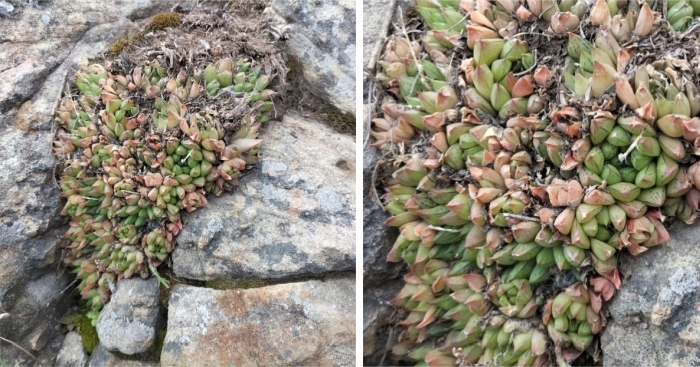
Fig. 5. A cluster of Haworthia marumiana var. reddii filling a sandstone rock crevice on a cliff at the Waterdown Dam.
Ecology
Ecology
Haworthia marumiana var. reddii plants form dense mats or small clusters that fill crevices on the shady side of the cliff. The leaves are semi-translucent, which allows light penetration. The succulence within the leaves allows the plant to survive long dry periods without rain. The leaves grow in compact rosettes, minimising water loss and exposure to excessive radiation on the exposed cliff faces.
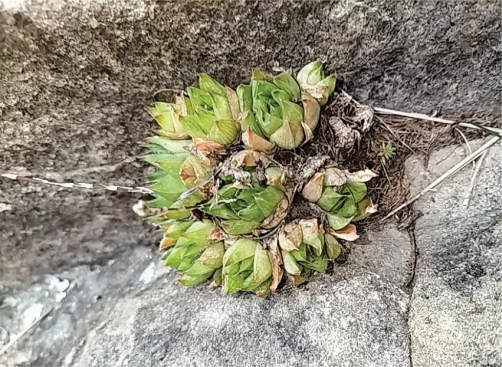
Fig. 6. A small cluster of Haworthia marumiana var. reddii growing in limited space of this sandstone crevice. Note the translucent leaves and windows.
The leaves becomes yellowish to pinkish during dry periods as the plants aestivate, blocking out excessive light and reducing photosynthesis. Plants are long-lived, with leaves withering from the base. The leaves becoming turgid after rain, but channelled during dry periods, an adaptation to dry periods experienced in its habitat.
The inflorescence grows ascending to spreading, the bilobed corolla is white, attracting the right pollinating flying insect. The seeds are small, ideal for establishment in crevices. The seed capsules becoming ascending after flowering and when mature they open from the top. The light and angular seeds are shaken from the capsules and dispersed by wind. Seeds ripen in summer and autumn, coinciding with the rainy season. Germination occurs within 14 to 21 days.
Plants sucker freely from the base, forming dense, rounded clusters. Continual sprouting from the base represents an efficient vegetative backup dispersal strategy for this harsh cliff-face environment. Detached clusters or heads will also root if they fall into a crevice.
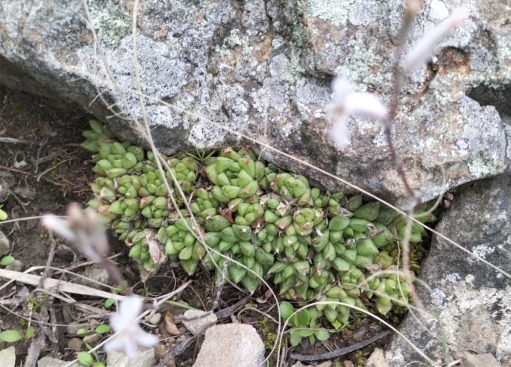
Fig. 7. Haworthia marumiana var. reddii growing in a sandstone rock crevice on the shady south facing cliff face at the Waterdown Dam.
Uses
Use
No medicinal or cultural uses have been recorded. Haworthia marumiana var. reddii is easily grown and responds well in cultivation, making a rewarding ornamental plant in containers, rockeries an miniature succulent gardens.
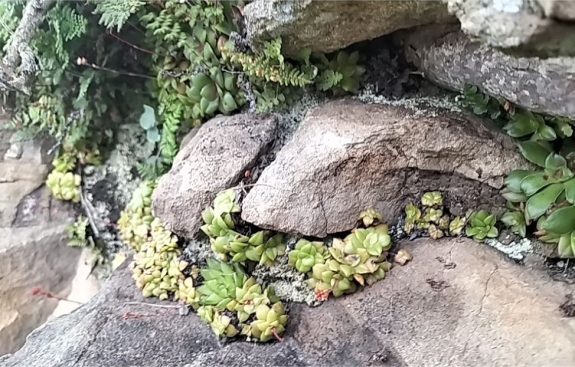
Fig. 8. A plant of Haworthia marumiana var. reddii in habitat, surrounded by Crassula orbicularis and the fern, Pellaea viridis, at Waterdown Dam, Eastern Cape.
Growing Haworthia marumiana var. reddii
Grow
Haworthia marumiana var. reddii is easily propagated from seed or division. It performs at its best grown as a pot plant in partial shade and kept in small containers or miniature succulent gardens, simulating the small crevices of the cliff environment. The soil should be sandy, well-drained and slightly acid, with ample feeding throughout the year. They will react to any fertiliser but organic fertilisers are best, such as well broken down compost. Outside its habitat, it is best grown as a pot plant under controlled conditions in a greenhouse or on a balcony or windowsill. It can be grown on rockeries and in artificial crevices created for it, planted on the shady side. This is an adaptable plant, best for cooler highveld grassland gardens. (Van Jaarsveld 2010). Plants are relatively fast-growing and respond well to watering and feeding, soon filling a container. In its natural habitat at the Klipplaat River at Waterdown Dam in the Eastern Cape district, it receives ample water during summer but less during the winter. Water should thus be given throughout the year, but sparingly in winter. The plants are frost-prone and should be protected during winter where frost can be a problem. The young plants start solitary, soon dividing and forming dense clusters.
Plants can be divided any time of the year, but this is better done in spring. Plant in a shallow tray in a sandy mixture (such as peat, sand and polystyrene) and keep moist. Rooting is within 3 weeks and once well rooted transfer to individual containers. Place container in a shady position but with full light. The south side of a building is ideal.
Sow seed in spring, summer or autumn in a sandy medium. First moisten the substrate with fine rose. Cover the seed lightly with a thin layer of sand. Keep moist and in a shady position. Germination is usually within 3 weeks and the young seedlings are relatively fast growing. Transplant seedlings to individual containers once large enough to handle.
Plants are relatively disease free but aphids, slugs and snails can sometimes be a problem.
References
- Bayer, M.B. 1999. Haworthia revisited, a revision of the genus. Umdaus Press, Hatfield.
- Duval, H.A. 1809. Plantae succulentae, in Horto Alenconio. Paris.
- Haworth, A.H. 1804. A. new arrangement of the genus Aloe. Transactions of the Linnaean Society 7: 11.
- Haworth, A.H. 1812. Synopsis Plantarum Succulentarum. London.
- Haworth, A.H. 1826. Description of new succulent plants. Philosophical Magazine 57: 92.
- Mucina, L. & Rutherford, M.C. (eds) 2006. The vegetation of South Africa, Lesotho and Swaziland. Strelitzia 19. South African National Biodiversity Institute, Pretoria.
- SANBI. 2020. Haworthia marumiana Uitewaal var. reddii (C.L.Scott) M.B.Bayer. National Assessment: Red List of South African Plants version 2020.1. Accessed on 2023/01/19.
- Scott, C.L. 1985. The genus Haworthia, a taxonomic revision. Aloe Books, Johannesburg.
- Scott, C.L. 1994. A new species of Haworthia, H. reddii. Cactus and Succulent Journal (US) 66:182.
- Smith, G.G. 1944. Some new species and varieties in the genus Haworthia: Journal of South African Botany 10: 22.
- Von Staden, L., Klopper, R.R. & Manning, J.C. 2014. Haworthia marumiana Uitewaal. National Assessment: Red List of South African Plants version 2020.1. Accessed on 2023/01/19.
Credits
Ernst van Jaarsveld
Kirstenbosch National Botanical Garden (Retired 2015)
Babylonstoren Farm
Extraordinary senior lecturer and researcher,
Department of Biodiversity and Conservation, University of the Western Cape
January 2023
Acknowledgements: the author thanks Cornell Beukes for assisting him in the field, and Jacub Jilemicky for help finding the plant in habitat (See Jacub’s website ‘All you want to know about Haworthia, Gasteria and Astroloba’ at WWW.Haworthia-Gasteria.com where he shares many more habitat photos.)
Plant Attributes:
Plant Type: Succulent
SA Distribution: Eastern Cape
Soil type: Sandy
Flowering season: Spring, Early Summer
PH: Acid
Flower colour: White
Aspect: Shade, Morning Sun (Semi Shade)
Gardening skill: Easy
Special Features:
Horticultural zones







Rate this article
Article well written and informative
Rate this plant
Is this an interesting plant?
Login to add your Comment
Back to topNot registered yet? Click here to register.